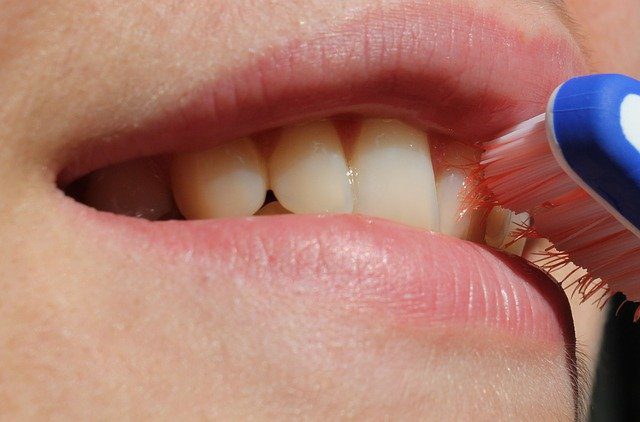With proper brushing, flossing, and regular dental cleanings, the roots of your teeth should be covered. Your jawbone holds the roots of all the teeth in your mouth, and gum tissue covers them both. In between the bone and the soft tissue is a transition zone known as the sulcus. This space is a battlefront in your mouth. It is where the body fights bacteria and plaque to keep them at bay. In a healthy mouth, the sulcus measures only one to three millimeters. However, the sulcus becomes enlarged when bacteria get out of control, causing swelling and even gum tissue recession.

(Pixabay / AlbanyColley)
Causes
Finding the roots of your teeth exposed can be unnerving at first. You have been brushing and flossing every day. How did this happen? While it can be the result of poor dental hygiene, that is not the only explanation. Unfortunately, even people with the best track record for brushing and flossing may still suffer from problems.
Gum Disease – Gum tissue infections such as gingivitis or periodontitis cause the gum tissue to pull away from the teeth. This recession opens up space for bacterial build-up. Since tobacco use increases your chances of developing gum disease, it can also be a significant contributor to gum recession.
Brushing Too Hard – Dentists recommend using a soft bristle toothbrush, but even a soft brush can cause damage to the gum tissue if used too aggressively. Ask your dentist for some guidance if you think you may be scrubbing your teeth too hard.
Tooth Grinding or Clenching – The muscles that open and close the jaw are powerful. Clenching or grinding teeth can create a significant amount of pressure on teeth and the surrounding soft tissue. Most people who clench or grind do so in their sleep. You may not even know that you are doing it. Waking up with a sore jaw or teeth may be a clue that grinding may be an issue. If you think you are regularly grinding your teeth at night, talk to your dentist about a mouthguard that will help cushion your teeth and mitigate the effects of grinding.
Tooth Movement – Misaligned teeth are more prone to develop problems with receding gum tissue. They are also harder to brush and floss effectively. If your teeth are poorly aligned, talk to your family dentist in Davis County about correcting them with braces or clear aligners.
If you do pursue orthodontic treatment, note that teeth may need to be moved significant distances. In the process of moving a tooth, one side of the tooth may erupt out of the jawbone. If it is not surrounded by bone, the tooth is left with only soft gum tissue to protect it from exposure. If you think your tooth is at risk, you should consult your orthodontist as soon as you notice a problem.
Symptoms
You may not notice the roots of your teeth showing at first. Subtle changes in the contour of the gum tissue covering the root can occur slowly. Over time, the symptoms of an exposed root will become more noticeable. The sooner you catch the problem and seek treatment from your dentist, the better.
Sensitivity – The roots of teeth contain nerves and are more sensitive than the upper part of the tooth. You may experience sensitivity to hot, cold, sour, sweet, or spicy foods.
Long Teeth – You may not be able to see a line where the enamel ends and the root begins. However, with more of the tooth exposed, your teeth may look longer than they did previously.
Swollen/Tender Gums – Infections in the sulcus will cause the surrounding gum tissue to become red and inflamed. You may notice bleeding when you brush your teeth.
Tooth Discoloration and Wiggling – If the infection reaches the bone tissue, it can cause color changes as it rots the bone tissue. Loss of bone and soft tissue holding the tooth in place allows the tooth to move around or even fall out.
Treatment Options
The best treatment is the one that your Utah dentist or orthodontist recommends for your specific situation. Treating receding gums can be a different process for each patient and will greatly depend on the problem’s initial cause. The protocol that works for one person may not work for the next one. Before beginning any treatment, your dentist will need to examine your teeth to determine how much gum tissue is left and whether it is still healthy or not.
If the problem is minor or early in its progression, your treatment may primarily be improving your oral hygiene. To jump-start the process, dentists or hygienists can perform a deep cleaning to include scaling below the gum line and planing the roots of your teeth. These procedures can remove tartar and bacterial build-up on your roots that may be preventing your gums from covering this space.
More advanced disease may require more complex procedures. Your dentist may choose to crown the tooth in question to cover both the tooth and the exposed root. This option may not work well, however, if multiple teeth are involved. A gingival mask is a removable cover that may be used to cover the roots of multiple teeth. Similarly, a gum graft can surgically cover the teeth again with your own gum tissue. In this procedure, tissue from the roof of the mouth is relocated to cover the roots of the affected teeth.
Most dental hygiene care takes place at home. Unfortunately, there is no reliable way to treat receding gums without the help of a dental professional. Dentists are trained to evaluate the cause and prescribe the best treatment to put you back on the path to long-lasting oral health.
